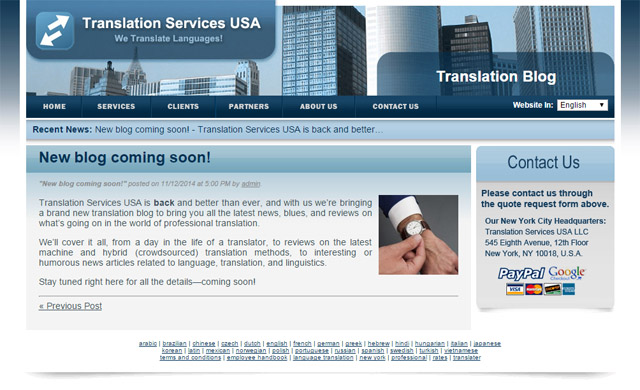Translation Services for New York City
Translation Services USA LLC11 Broadway, STE 552
New York, NY 10004 Phone: +1 (212) 380-1679
Email: sales1-at-translation-services-usa-dot-com
What is Hybrid Translation?
(And What are its Pros/Cons?)
Hybrid Translation is a process of translation that incorporates both machine translation and human translation. Initially, the text is translated by a machine (Google Translate, Bing Translator, etc.) and the resulting translation is then proofread and edited by a human translator. This practice is also commonly referred to as “post-editing”. The finished translation is oftentimes stored in Translation Memory for future use.

Hybrid Translation was developed as a means to combine the speed of machine translation with the accuracy of professional translation.
Example of a Hybrid Translation program:
Pros
The result is
- A more accurate translation of the original document (as opposed to machine translation alone)
- Faster turn-around time
- Lower cost
Professional translators themselves have expressed mixed feelings about the Hybrid Translation process. On one hand, some of the translators reported that although they generally receive a lower rate for their work (proofreading rate), the process is quicker and they are able to work on more projects in a given day. Also, formatting is not an issue as all of the text is put through a machine translator first providing easily editable strings of text for the translator to review.
Example:

On the other end of the spectrum, some translators have mentioned that the process is actually longer than traditional translation, as sometimes the machine translation is so inaccurate, it takes much more time figuring out what the translation means than it would take just to translate from the original.
Cons
- Can sometimes take longer if machine translation is not accurate/confusing
- Text that is technical in nature can’t be used in machine translators
- Can’t handle formatting
Ultimately there are good things and bad things about Hybrid Translation. While it may not be ideal choice of translation processes for perhaps a legal document, it may be the best solution when translating a large quantity of text (perhaps for back pages of a website) where accuracy takes a backseat to speed and cost.




